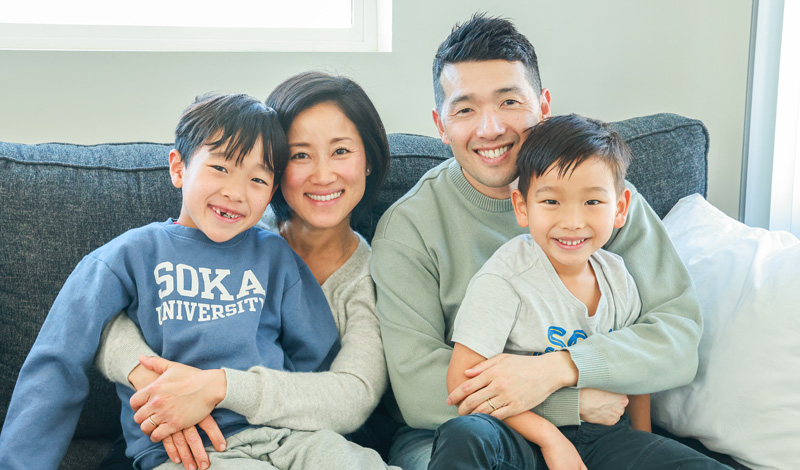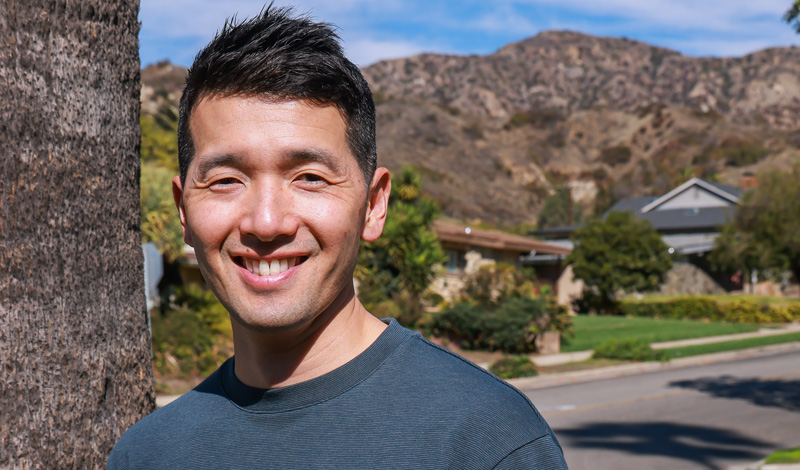by Isamu Yoshioka
Altadena, Calif.
The Santa Ana winds were gaining strength, more powerfully than they had in years. I stepped onto our back porch and took stock of the huge old oak at the back edge of our lawn, its crown wheeling crazily above. “It is time we trim that thing,” I told my wife, Suhjin, stepping in from the wind. For years we’d put it off, but agreed now that it was time. About an hour later, we got a knock on the door: arborists looking for work. We gave them some. That same day, the Eaton Fire broke out.
I was home with Suhjin and the boys when we got notice of the fire spreading rapidly through Eaton Canyon, just two miles away. We explained to the kids that there was a fire, that we were safe, but that, if it got closer, we’d need to be ready to leave at a moment’s notice. We packed our bags and called my sisters in Gardena to prepare for the possibility. And then we chanted together, turning at some point to face the fire, whose glow was visible on the horizon. When we got the notice to evacuate that evening, we rolled up the Gohonzon and left.
I took the next couple days off from work to get us situated at my sisters’. Our first day there, we just chanted, Suhjin and I, not knowing what had happened to our home. At midday, we got a call from a neighbor—she’d ventured back to our street and found our home standing—covered in soot, but standing. If we wanted to take a look, she said, now would be the time.
Suhjin and I went, weaving through the debris in the road, through burned out houses and smoldering cars. We got there and began packing up the remaining essentials. I was fully focused on the task at hand—getting in and getting out as safely and swiftly as possible—but a few details did catch my attention: The stone wall at the back of our yard, once carpeted with flowers and vines, was scorched bare, the vegetation a black heap at its base. One of the windows at the rear of the house had bubbled and burst, and the kids’ toy bin at the back edge of our lawn had puddled to tar. The oak there, too, was scorched at its trunk, but no farther—the downed and low hanging branches had been trimmed and hauled away, giving the fire little to feed on, little to climb.
While heading to the car, I spotted Nick, our neighbors’ son, a young man in his early 30s. It was hard to make him out in the dusk, doubly overcast from the soot and smoke. “Hey man!” I called. “Hey!” he called back. We couldn’t make out half of what the other said, but I gathered that he’d been here the night before—he’d come back after evacuating—hosing down his parents’ house and ours. I thanked him, but frankly, didn’t get to say all I wished to say.

That evening, back at my sisters’ place, Suhjin and I recounted what we’d seen. From what we gathered on glancing at the back property, the fire had come remarkably close to the house. Our conversation was cut short by a phone call from our neighbor, Lynn, Nick’s mother. She explained that Nick had done more than spray the yard. He’d sprayed down their home and ours, beginning with the oak, perhaps the most likely thing to catch flame, moving on to the stone wall around the back of the property, beyond which, he saw that our neighbor’s home was in flames. He climbed to our roof and from there took aim at the house behind us, dousing it with water, curbing the flames at the
boundary line.
I returned to work one day later, to the emergency room. Before I did, though, I did morning gongyo with particular intensity, drawing on a prayer I’d maintained since 2005, in my first few months in premed, when I was struck, out of the blue, by illness. Imminent kidney failure, the doctors had said. Incurable, even by transplant.
I was at home with my parents at the time, and my mother got me to join her morning and evening in front of the Gohonzon, encouraging me to “chant with the intensity to change the very cells in your body.” For weeks I battled to bring forth a glimmer of hope from the depths of rage and despair.
I underwent my treatments in secret, at a hospital near our home in New Jersey. At the same time, I continued on in my premed studies at Columbia University in New York. I didn’t tell my friends at school; I didn’t want them to see me as a patient a sick person, a victim. But my view of medicine, of doctors and patients, was changing, quite dramatically, day by day. I was no longer just a student of medicine, but a patient too. As I chanted fervently to become healthy so I could fulfill my mission as a doctor for kosen-rufu, I determined that I would not permit illness to prevent me from doing what I’d decided to do. In the course of these treatments, I had an aha moment, as I was wheeled from one room to another on a gurney, wearing nothing but the hospital gown: There’s no distinction between doctors and patients—we’re people, equally people, no more for the white coat and no less for the gown.
I learned in those days what we ask of patients—the extraordinary demand
we make of them—nothing less than that they put their trust in a total stranger.
In the days and weeks that followed, a prayer emerged from my life: To be worthy of that trust; to give myself fully to the person right in front of me, my all to their humanity and their recovery. Within a year, my illness was declared in remission, and several years out, declared cured, something I never expected to hear.
The ER does have a way of lending perspective—everyone is in some kind of crisis. Returning for my first day of work since evacuating, I put my personal problems aside. We were safe and together. What more could we possibly ask for?
It feels like ages ago, but only last year, I was recognized in the top percentile of patient satisfaction. A rarity for an ER doctor, for whom patient interactions are often so brief, amid pain and chaos. I was taken aback, and also rather moved, that there’d been those who’d not only remembered, but remembered with appreciation the interactions we’d had. I think I owe this to the prayer that began in the early days of medical school, where I was a patient as well as a student, to be fully present at every moment, fully acknowledging the humanity of the person right in front of me.
I haven’t seen Nick since we crossed paths on our front lawns, under the soot and haze of the fire. We haven’t yet moved back to our home in Altadena—it is not clear yet when it will be safe to do so. And anyways, Nick is traveling the world now, doing his DJ thing. But I hope to see him again someday, to thank him again, somewhere calm and clear, where we can see each other face to face. He taught me, as I hope I have my patients, to trust a little more in the goodness of strangers.
You are reading {{ meterCount }} of {{ meterMax }} free premium articles

